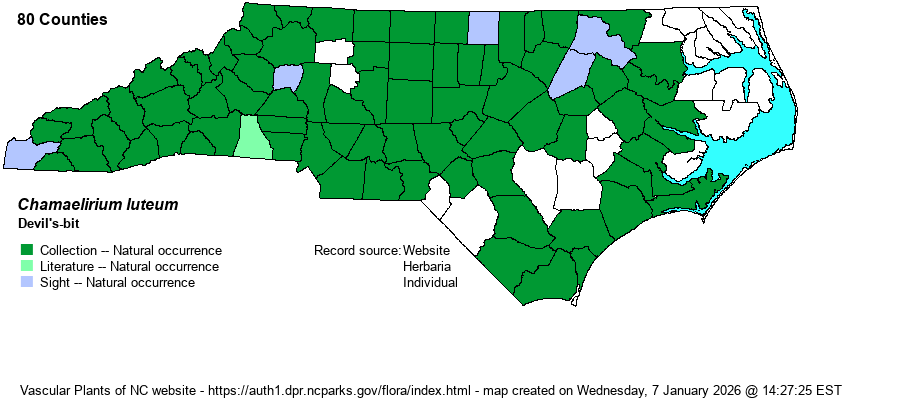| Author | (L.) A. Gray | |
| Distribution | Nearly throughout the state, but absent or essentially so in the northeasternmost counties; no records yet east of Bertie, Beaufort, and Carteret counties.
It has a wide range in the Eastern states, ranging from western New England west to southern Ont., OH, and southern IL, and then south to central FL and LA. It is scarce west of OH, and also is scarce to absent over the Delmarva Peninsula, far eastern VA, and nearby northeastern NC.
| |
| Abundance | Fairly common to common over the Mountains and most of the Piedmont; infrequent to fairly common (at least locally) in most of the Coastal Plain, but very rare to absent in the northeasternmost counties. | |
| Habitat | This is a species mainly of mesic to fairly rich wooded soils, but not one of truly high pH soils. It is most often found in Mesic Mixed Hardwood Forests, but it can also be found in Acidic Cove Forests, bottomland or other streamside forests, and other similar places. It can occur in fire-maintained, wet pine savannas in the lower Coastal Plain, a very odd habitat for it. | |
| Phenology | Blooms in April and May; fruits from September to November. | |
| Identification | This is a lily with a basal rosette of several evergreen leaves. The leaves are spatulate (much wider above the middle) and rounded at the tips, averaging about 5 inches long and 1.5 inches wide. The flowering stalks differ by the sexes (a rare herbaceous plant with separate sexes); male stalks grow to about 2 feet tall, whereas the female stalks are a bit taller, to about 2.5-3 feet tall. In addition, the stalks contain smaller leaves that are reduced farther upwards. The male spike of dense and very small white flowers averages about 5 inches long, and this spike droops at the tip when mature. The female spike eventually reaches 8 inches or more, and it remains erect; it also has very small white flowers. As a rule, most of the plants in a population are the male (staminate) ones, with female (pistillate) plants more scattered and not quite as showy or densely white-flowered. Nonetheless, the plants can be seen at long distances near the forest floor when in bloom. As with many plants having evergreen leaves in a rosette, biologists often run across such "rosette" plants with a cluster of dark green leaves on a winter or very early spring walk. This species tends to have a bit longer and more spatulate leaves than some others, but identifications of plants with only basal leaves visible must be made with care, especially vs. Carphephorus bellidifolius. Thankfully, it is fairly widespread over most of the state, and you should see the species at least a few times in a spring or summer season. | |
| Taxonomic Comments | This is a monotypic genus. There is one other genus in the Family Chionographidaceae, in eastern Asia.
| |
| Other Common Name(s) | Fairy-wand is also quite often used. False-unicorn | |
| State Rank | S5 | |
| Global Rank | G5 | |
| State Status | | |
| US Status | | |
| USACE-agcp | FACU link |
| USACE-emp | FAC link |

